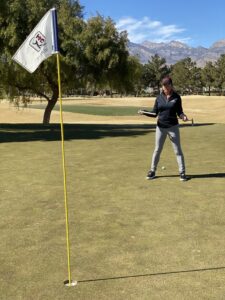
I recently met here in Las Vegas with Mario Bevilacqua, who Golf Digest ranks as one of top teachers in America. We discussed the most common misconceptions people have regarding reading putts. I want to begin with a post about putting misconceptions because we hear and see them all of the time. My next post will be about things you should pay more attention to when putting. Let’s get to it…
 1. Big things, like a river, influence the break of a putt. FALSE.
1. Big things, like a river, influence the break of a putt. FALSE.
It’s not where a river or creek or the ocean is, where the valley floor or downtown is, or that all putts on the course break away from some nearby mountain(s). Look solely across the ground where your ball is going to roll to the hole. That slope alone is what is going to make your ball break. “It’s easy to get caught in these so-called truisms,” Mario warned. “Gravity and friction act on the ball when there is side slope, which you feel in your feet or see if you look at your line with your hands on the sides of your face like horse blinders.” Horse blinders, of course, are designed to eliminate distractions (think, mountains, creeks, etc.) and that’s exactly what we are talking about here.
2. Play the same amount of break, regardless of whether the putt is uphill or downhill. FALSE.
This may be putting 101 to some but many people don’t realize that a putt that is downhill will break more than a flat putt. And the reverse is also true — a putt that is uphill will break less than a flat putt. Downhillers break more because the ball is rolling more slowly and more subject to gravity. Uphillers break less because they are moving faster and less subject to gravity.
3. Looking at the hole from both sides helps you accurately read break. FALSE.
Mario says that recreational golfers shouldn’t look at putts from the opposite side of the hole. As often as not, this second view will just confuse you. Instead focus only on the ground your ball has to cover from its origin to the hole.
I hope this is helpful! Look for next week’s post regarding 3 things to pay attention to when putting.



 1. Big things, like a river, influence the break of a putt. FALSE.
1. Big things, like a river, influence the break of a putt. FALSE.